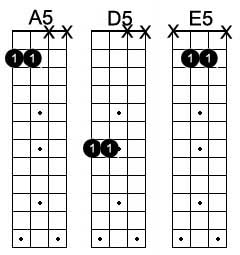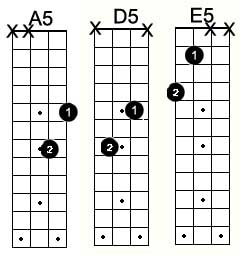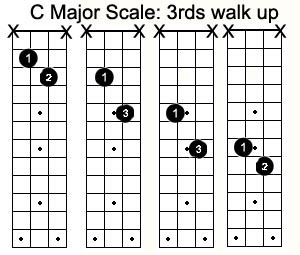« The origin of a new string: D'addario FW74 |
Main
| More fretboard geometry--Maj7 arpeggios »
 October 14, 2010 | Fretboard Geometry October 14, 2010 | Fretboard Geometry
Intellect. Touch. Space. Sound. Everyone attacks the way they master their instrument differently, utilizing these individual components of playing. Initially, most of us just feel the position of the finger or fingers on the strings, and hopefully, we're rewarded by a pleasant sound. As we progress, we start to notice relationships. These can be as complex as music theory, the mathematical relationships between notes and their function through time, or it can be as simple as the just the way the notes or chords feel after repetition in the fingers. Even the spatial relationships can register as a part of motor function and how the music feels in the hands.
We talk a lot about the theory behind the mandolin here on the site. The dirty little secret of our 8-string wonder is you can move similar patterns with ease because of the magnificent symmetry of the 5ths tuning. It's as much a function of geometry as anything, and we want to take a look at some simple visual patterns and how they can be repeated up and down the fretboard, and across strings. You might absorb this tactilely eventually too, but we've blocked out some graphics to assist demonstrating the concept.
The instrument is traditionally tuned in 5ths. This means open string pairs will give you the drone Perfect Fifth, but it also gives you the same pairs relationship as you close up the strings and move it up the fretboard. That Power Chord A5, A and E is simply two strings next to each other. Move it up five frets and you have a Power D5. Shift it across a string and you have an E5.
So what? This is in essence your 'I, IV, V' chord, repeatable in numerous keys and transpositions. Whole musical careers have been launched on little more than these chords, and you can do it with just one finger on the mandolin. The Power 5 chord is not just a Rock and Roll sound, it offers some delicious ambiguity in contemporary music, the with the lack of definitive "major-ness" or "minor-ness." It was also a big hit with the Gregorian Monks back in Medieval times.

You can get a similar sound from its inversion, putting the 5th of the chord in the bottom, and the root at the top. This is also as important melodically as it is harmonically. Think of several tunes that start on the 5th of the scale, "Here Comes the Bride," "How High the Moon," "Ornithology," as examples. If you have identified the root of the scale or chord, the relationship on the fretboard is always the same, down a string, up two frets. That geometric relationship is a good trick to know. Now you have two notes you can immediately jump to when your improvising. It's just a matter of filling out the notes of the scale in between.

When we close in that two fret span to just one, we have an alluring aural treasure, the Tritone or the diminished 5th (#4). This is fretboard geometry you can exploit any time you play a Dominant 7th chord. It's the guts of the V7 chord, and powerful harmonic fodder. When you recognize and physically internalize this relationship, you can have all kinds of fun landing on it while improvising.
 
You can also slide it down some frets and develop a whole sequence of Circle of Fifths patterns. You don't need all four notes of the chord, these two are powerful enough on their own.
These are 5ths and 4ths, easily grasped on the mandolin fretboard, but you can also have some fun with 3rds. The following is a great little pattern you can move up and down in different keys and and harmony to your own melody. Notice graphically, sometimes there is a one fret span and sometimes there are two, depending on where you are in the scale. Getting to know where those are will give you some powerful tools for creating melody and harmony in almost any genre of music.

Many feared studying geometry in school, but ultimately found it useful in life, whether shopping for carpet or learning to parallel park. On the mandolin, geometry is your friend too. Use it as yet another tool for fretboard mastery.
Further:
GRIP #1
Mobility--chord transit
Two-chord jam; feed the beast.
Posted by Ted at October 14, 2010 10:22 AM

Disclaimer: In the 'Information Age' of the 21st Century,
any fool with a computer, a modem, and an idea can
become a self-professed 'expert." This site does not
come equipped with 'discernment.'
|



